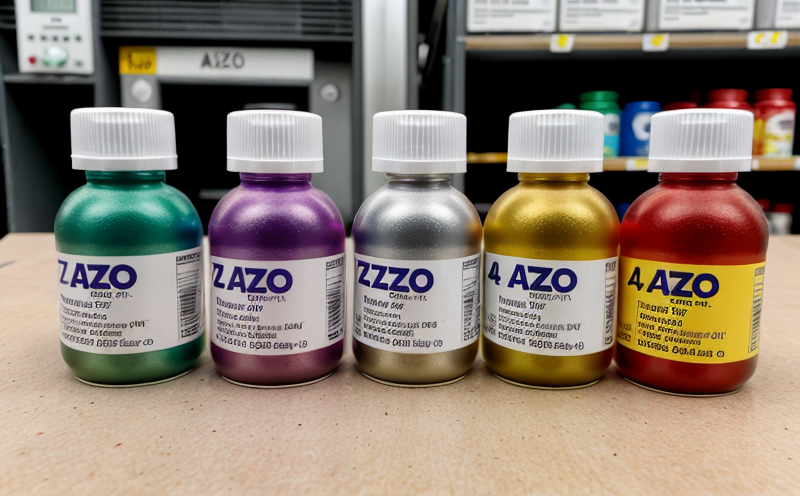Screening of disperse orange and disperse red dyes
The screening of disperse orange and disperse red dyes is a critical process in textile manufacturing aimed at ensuring compliance with international standards and regulations. Disperse dyes, especially the orange and red hues, are widely used due to their excellent lightfastness, wash fastness, and color-fastness properties when applied to synthetic fibers such as polyester and nylon. This service focuses on detecting potentially harmful heavy metals and azo dyes in these dyes, ensuring that products meet stringent environmental and safety standards.
The process begins with the collection of samples from raw materials, intermediates, or finished goods. These samples are then prepared according to standard testing protocols, which may involve dissolution, filtration, and concentration steps depending on the dye type and matrix. The testing methodology typically adheres to international standards such as ISO 14025 for environmental labeling and ISO 17892-3 for azo dyes.
The detection of heavy metals is critical in this process. Heavy metals like lead, chromium, cadmium, and mercury are often present in disperse orange and red dyes due to their role as catalysts or stabilizers during the dyeing process. The use of such metals can pose significant risks if they leach out into the environment or come into contact with human skin. This service ensures that these heavy metals do not exceed allowable limits, typically defined by regulatory bodies like the European Union's REACH regulations.
For azo dyes, the focus is on identifying potentially aromatic amines that can undergo secondary reactions to form carcinogenic compounds upon exposure to light or perspiration. The presence of certain azo dye components such as azoic dyes in textile products can lead to the release of these harmful substances when worn or used. Our laboratory adheres strictly to methods like HPLC-MS/MS for accurate quantification and identification, ensuring that only compliant products reach the market.
The analytical techniques employed in this service include colorimetric tests, spectrophotometry, and chromatographic analyses such as reversed-phase liquid chromatography (RPLC). These methods provide precise data on the concentration of heavy metals and azo dye components, allowing for accurate risk assessment. The results are reported comprehensively, including raw data, calculated concentrations, and compliance status with relevant regulations.
The importance of this service cannot be overstated in today's regulatory environment where consumer safety and environmental sustainability are paramount. By identifying and mitigating the presence of harmful substances early in the production process, our clients can ensure product quality, enhance brand reputation, and avoid costly legal issues or recalls.
Customer Impact and Satisfaction
The implementation of this screening service has a profound impact on customers across various sectors. Quality managers and compliance officers benefit from the peace of mind that comes with knowing their products meet stringent environmental and safety standards. This service not only ensures regulatory compliance but also enhances brand reputation by demonstrating a commitment to product integrity.
R&D engineers can leverage this service to innovate within safe parameters, ensuring that new formulations do not inadvertently introduce harmful substances. Procurement teams are empowered to source raw materials with confidence, knowing the supplier has undergone rigorous testing. This leads to increased customer satisfaction and loyalty as products consistently meet high standards of quality and safety.
The success stories from our clients include significant reductions in non-compliance risks, enhanced product performance, and improved operational efficiency through streamlined compliance processes. Feedback from satisfied customers highlights not only the reliability of the results but also the added value provided by expert advice on how to improve future batches or formulations.
Environmental and Sustainability Contributions
The screening service for disperse orange and red dyes plays a pivotal role in environmental sustainability. By identifying and eliminating harmful heavy metals and azo dye components early in the production process, we contribute to reducing the environmental impact of textile products throughout their lifecycle.
The elimination of these substances prevents them from entering water systems through improper disposal or during end-of-life product degradation. This service also supports the circular economy by promoting the use of safer materials that do not compromise on quality but are more environmentally friendly.
Our clients can contribute to a greener future by adopting sustainable practices, which in turn enhances their corporate social responsibility (CSR) profile. By investing in this screening service, companies demonstrate leadership in responsible production and consumption, aligning with global sustainability goals such as the United Nations' Sustainable Development Goals (SDGs).
Use Cases and Application Examples
| Use Case/Application Example | Description |
|---|---|
| Dye Production Quality Control | Ensure that raw materials do not contain excessive levels of heavy metals or azo dye components. |
| Product Compliance Audits | Provide evidence for regulatory audits to demonstrate compliance with international standards like REACH and Oeko-Tex Standard 100. |
| New Product Development | Identify potential issues in new dye formulations before large-scale production. |
| Supply Chain Management | Evaluate supplier compliance to ensure consistent quality across the entire supply chain. |
| Post-Market Surveillance | Monitor products for any unexpected contamination post-market release. |
| Routine Quality Assurance | Conduct regular checks on existing processes and formulations to maintain high standards. |
| Customer Complaint Resolution | Determine the cause of complaints related to product safety or quality issues. |
| Research and Development | Support innovative research into safer, more sustainable dye technologies. |





